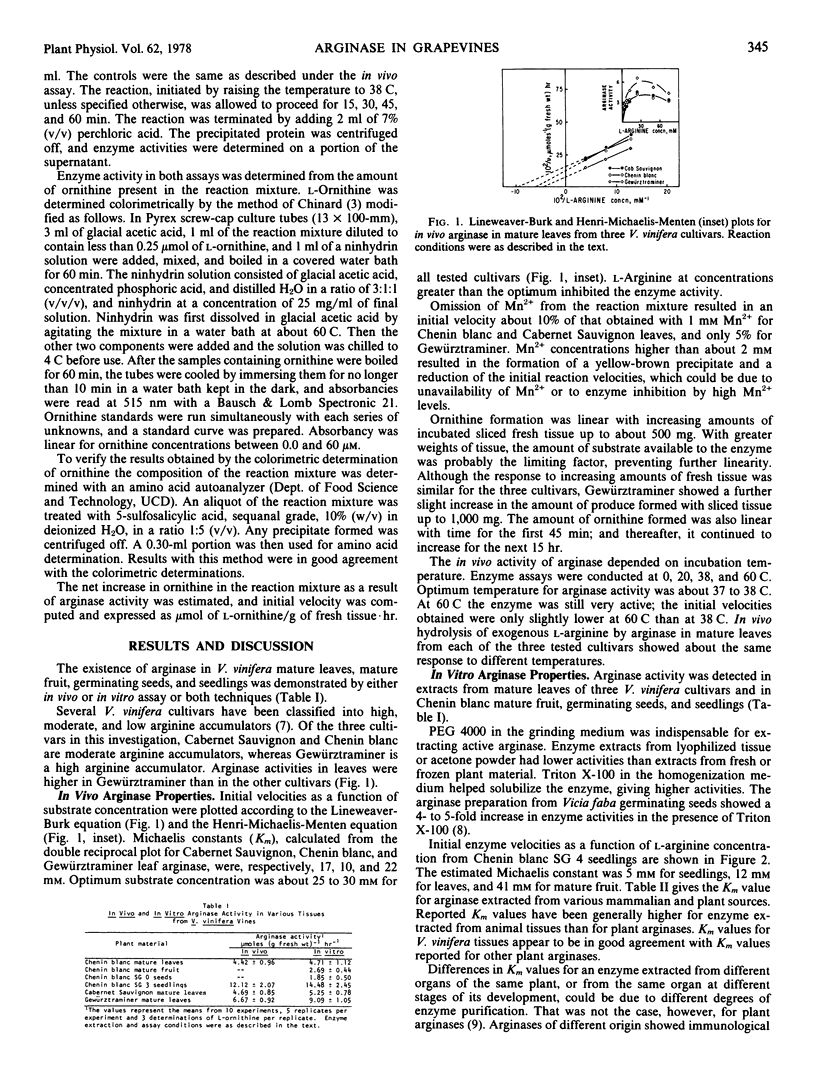Abstract
The presence of arginase (EC 3.5.3.7) in various tissues from Vitis vinifera L. cultivars was demonstrated by both in vivo and in vitro enzyme assays. Initial velocities determined by the two methods were in close agreement. Optimum conditions for maximum enzyme activity were 25 to 30 millimolar l-arginine, about 1 millimolar Mn2+ (pH 9.4 to 9.8), and incubation temperature of 37 to 38 C. l-Arginine hydrolysis was linear with increasing sliced fresh tissue up to 500 milligrams for in vivo assay, and with enzyme extract equivalent up to about 200 milligrams of fresh tissue for in vitro. Similarly, l-arginine hydrolysis was linear with incubation time for the first 45 minutes for in vivo assay and for the first 20 minutes for in vitro.
Full text
PDF



Selected References
These references are in PubMed. This may not be the complete list of references from this article.
- Cabello J., Prajoux V., Plaza M. Immunodiffusion studies on human liver and erythrocyte arginases. Biochim Biophys Acta. 1965 Sep 20;105(3):583–593. doi: 10.1016/s0926-6593(65)80241-7. [DOI] [PubMed] [Google Scholar]
- Damodaran M., Narayanan K. G. A comparative study of arginase and canavanase. Biochem J. 1940 Nov;34(10-11):1449–1459. doi: 10.1042/bj0341449. [DOI] [PMC free article] [PubMed] [Google Scholar]
- Kollöffel C., van Dijke H. D. Mitochondrial Arginase Activity from Cotyledons of Developing and Germinating Seeds of Vicia faba L. Plant Physiol. 1975 Mar;55(3):507–510. doi: 10.1104/pp.55.3.507. [DOI] [PMC free article] [PubMed] [Google Scholar]
- Mora J., Tarrab R., Bojalil L. F. On the structure and function of different arginases. Biochim Biophys Acta. 1966 Apr 12;118(1):206–209. doi: 10.1016/s0926-6593(66)80161-3. [DOI] [PubMed] [Google Scholar]
- Mora J., Tarrab R., Martuscelli J., Soberón G. Characteristics of arginases from ureotelic and non-ureotelic animals. Biochem J. 1965 Sep;96(3):588–594. doi: 10.1042/bj0960588. [DOI] [PMC free article] [PubMed] [Google Scholar]
- Muszyńska G., Reifer I. Purification, properties and inhibition of plant arginase. Acta Biochim Pol. 1968;15(1):55–66. [PubMed] [Google Scholar]
- Muszyńska G., Reifer I. The arginase inhibitor from sunflower seeds: purification and inhibitory properties. Acta Biochim Pol. 1970;17(4):247–252. [PubMed] [Google Scholar]
- Muszyńska G., Severina L. O., Lobyreva L. W. Characteristics of arginases from plant, ureotelic and uricotelic organisms. Acta Biochim Pol. 1972;19(2):109–116. [PubMed] [Google Scholar]
- Roubelakis K. A., Kliewer W. M. Enzymes of Krebs-Henseleit Cycle in Vitis vinifera L: I. Ornithine Carbamoyltransferase: Isolation and Some Properties. Plant Physiol. 1978 Sep;62(3):337–339. doi: 10.1104/pp.62.3.337. [DOI] [PMC free article] [PubMed] [Google Scholar]
- Roubelakis K. A., Kliewer W. M. Enzymes of Krebs-Henseleit Cycle in Vitis vinifera L: II. Arginosuccinate Synthetase and Lyase. Plant Physiol. 1978 Sep;62(3):340–343. doi: 10.1104/pp.62.3.340. [DOI] [PMC free article] [PubMed] [Google Scholar]


